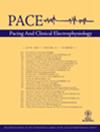使用微电极导管阐明左心房电位:一例冠状窦腔闭锁伴小的持续性左上腔静脉的病例。
IF 1.7
4区 医学
Q3 CARDIAC & CARDIOVASCULAR SYSTEMS
Pace-Pacing and Clinical Electrophysiology
Pub Date : 2024-10-01
Epub Date: 2024-03-29
DOI:10.1111/pace.14977
引用次数: 0
摘要
一名 51 岁的女性反复出现心悸。心电图显示窄QRS心动过速,短RP构型。计算机断层扫描显示冠状窦(CS)闭锁,并伴有一个小的持续性左上腔静脉(PLSVC)。电生理学研究发现,逆行性最早心房激活点(EAAS)位于CS骨膜处,但无递减特性,副希氏起搏提示逆行性房室结传导。使用 1.6-Fr 微电极导管经由 PLSVC 远端置入 CS,证实 EAAS 位于左心房,而非 CS 腔。经房间隔入路发现了左外侧辅助通路,并成功消除了该通路。本文章由计算机程序翻译,如有差异,请以英文原文为准。
Elucidating left atrial electrical potential with microelectrode catheter: A case of coronary sinus ostial atresia with small persistent left superior vena cava.
A 51-year-old woman presented with recurring palpitations. Electrocardiography revealed narrow QRS tachycardia with short RP configuration. Computed tomography showed coronary sinus (CS) ostial atresia along with a small persistent left superior vena cava (PLSVC). Electrophysiological study identified the retrograde earliest atrial activation site (EAAS) at the CS ostium without decremental properties, and para-Hisian pacing suggested retrograde atrioventricular nodal conduction. Using a 1.6-Fr microelectrode catheter distally placed in the CS via the PLSVC, EAAS was confirmed within the left atrium, not the CS ostium. Transseptal approach revealed a left lateral accessory pathway, which was successfully eliminated.
求助全文
通过发布文献求助,成功后即可免费获取论文全文。
去求助
来源期刊

Pace-Pacing and Clinical Electrophysiology
医学-工程:生物医学
CiteScore
2.70
自引率
5.60%
发文量
209
审稿时长
2-4 weeks
期刊介绍:
Pacing and Clinical Electrophysiology (PACE) is the foremost peer-reviewed journal in the field of pacing and implantable cardioversion defibrillation, publishing over 50% of all English language articles in its field, featuring original, review, and didactic papers, and case reports related to daily practice. Articles also include editorials, book reviews, Musings on humane topics relevant to medical practice, electrophysiology (EP) rounds, device rounds, and information concerning the quality of devices used in the practice of the specialty.
 求助内容:
求助内容: 应助结果提醒方式:
应助结果提醒方式:


